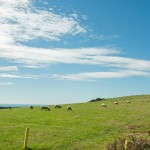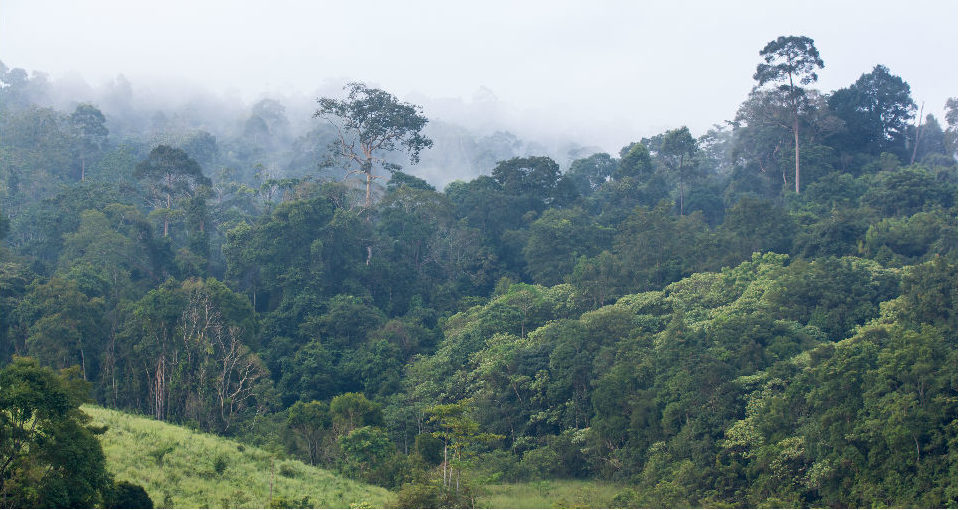
Thailand’s National Parks
Have you considered visiting Khao Yai one of the biggest of Thailand’s many national parks? I would hazard a guess that many of Thailand’s 35 million tourists are unaware that there are 127 national parks in the country. These parks, which include 22 marine protected areas, offer a home to a diverse range of flora and fauna. Their populations include many endangered animals, such as tigers, elephants, leopards, tapirs, gaurs, bears and various species of monkey. Do you know that around 10% of all marine species in the world can be found around Thailand? And that Thailand is renowned as one the best bird-watching destinations in Asia?
Khao Yai
Established in 1962, Khao Yai was the Thailand’s first national park, it is today the third largest, and probably remains the country’s best known. The park is situated mainly in Nakhon Ratchasima Province in the North East (Issan) of Thailand. A designated UNESCO World Heritage Site, it covers an area of nearly 2,200 km², which includes large areas of rainforest. The park’s main gate entry point is a mere 2.5 hours drive from Bangkok, from where a sizeable portion of its 1 million annual visitors originate.
There are around fifty hiking trails throughout the entire park, which follow the migratory paths of wildlife. Various types of deer, gibbons and other monkeys can be readily spotted, elephant’s perhaps a little less easily so. There is also good potential for spotting rare breeds of exotic birds and reptiles. For those wishing to venture a little off the beaten track, to enhance the possibilities of encounters with the likes of porcupine, bear, gaur, various wild cats, etc., it’s possible to arrange for park rangers to serve as guides.
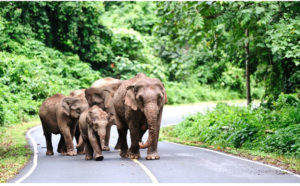
Entrance fees and visiting hours
The park is open 6 am to 6 pm everyday all year round, however vehicles already inside the park at closing time are allowed to stay later. You are only permitted to stay in the park overnight if you have you have pre-booked accommodation. The park is a very popular destination for Thais, and subsequently, can be very busy on week-ends and local holidays.
The northern (main) entrance lies about 25 km from nearest town Pak Chong, which is about 180 km from Bangkok. The alternative second entrance, but more difficult to reach, is at the south of the park in Nakhon Nayok province. The entrance fee is 400 THB for adults and 200 THB for children. If you choose to camp or stay at one of the very basic park bungalows, the entrance fee is valid for up to 3 days.
Bangkok to Khao Yai
Locals travelling from Bangkok often chose to make the 2.5 hour drive to the park and return home in the same day. Others will perhaps stay for a day or two at one of the many luxury resorts that are situated along the road from Pak Chong. Many foreign tourists, especially those on group tours, opt to visit the park by minibus, direct from Bangkok, using a tour company. This is very convenient, as there is no form of transport within the park.
However, if you prefer independent travel, by far the cheapest way to visit Khao Yai is to make Pak Chong your base. The accommodation cost here (500 – 600 THB) for a pretty decent room is typically 25% of the resort accommodation cost in the Khao Yai area. As Pak Chong lies on the main rail and road route between Bangkok and Thailand’s third city, Nakon Ratchasima (aka Korat), getting there is relatively easy.
Getting to Pak Chong
You can get to Pak Chong from Bangkok by minibus, regular service bus or train. Minibuses leave from Victory Monument (close to the BTS entrance – Sukhumvit Line) on a first come first served basis at a cost of 250 THB per person. You shouldn’t need to wait more than 20 minutes – the trip takes about 2.5 hours. You can also take a regular service bus from Morchit (Northern) Bus Terminal for 180 THB – they leave about every 30 minutes and take about 3 hours. Alternatively, you can take the train from Bangkok’s main train station, Hua Lamphong, situated on the edge of the city’s Chinatown. There are 6 or 7 trains daily, the express train takes 3 hours, and the slowest train another 40 minutes, since it stops at every station on route.
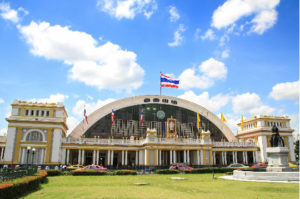
Hua Lamphong Train Station, Bangkok
It had been more than decade since I last took a train in Thailand, so I decided to make my way to Hua Lamphong. The train carriage was clean and tidy, if not lacking a little comfort, but with all the windows fully open the air conditioning worked a treat. The scenery along the route is pleasant rather than spectacular, but with the journey costing a meagre 36 THB (a little over 1 USD), it’s difficult to have any complaints.
Pak Chong is a typical provincial Thai town. I was surprised by the apparent very low foreign tourist numbers, given its proximity to Khao Yai. In the town, there is the obligatory bustling night market, selling the usual street food, cheap clothes and trinkets. Nightlife is obviously limited, however there are some of bars and restaurants in a cluster along the main road at the east end of town. The one I visited, provided reasonable quality food at a decent price.
Pak Chong to Khao Yai
As mentioned, it’s around 25 km from Pak Chong to the park. You can get a ‘song thaew’ (local taxi) to take you to the main parks main entrance from Pak Chong but since they are not allowed to enter the park, you would have to rely hitching a lift around the various sites. You can hire a car in Pak Chong, which can usually be best done along with your hotel booking. Alternatively, if you happen to be in Korat you could hire a car there, since its only 80 km east of Khao Yai. Prices obviously vary but 1200 THB for a small car and 1800 THB for a salon type vehicle per day would be somewhere near the mark.
The alternative is to hire a ‘scooter’ for the day, which costs 300 THB with insurance. Although these small (usually 125 cc) fully automatic motorbikes are relatively easy to ride it should be acknowledged that driving conditions in Thailand are very different from the west. With 24,000 fatalities per year, the Thai road death rate per capita is amongst the highest in the world. Putting that into context, with an almost identical sized population to the UK, road deaths are tenfold. Thus, I certainly couldn’t recommend use of a scooter for the complete novice to Thailand.
Approaching Khao Yai from Pak Chong you will observe some bizarre architecture that you could have least expected in rural Thailand. These buildings are part of a number of themed parks, restaurants and hotels that border the road. The themes range from an olde world styled Italian village to the American wild west ranch complete with cowboys and indians, from a hobbit village to a German medieval castle. The buildings really look quite impressive and if I had allowed more time in my itinerary, some would have definitely warranted a closer inspection. There is a small cover charge at most of the sites (100 – 200 THB) should you wish to take eat there or take a quick look around.
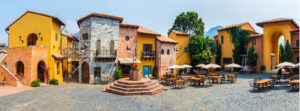
A day at the Park
My first stop was at the viewpoint (Km 30) about 5 km from the main gate. Gathered here was a group of highly enthusiastic Thai birdwatchers with some serious photography equipment. They were there to photograph the elusive hornbill (there are 5 sub-species in Khao Yai), which is rare in most of the rest of Thailand. Apparently, they tend to become a little more gregarious during the rainy season, when ripened jungle fruit is abundant.
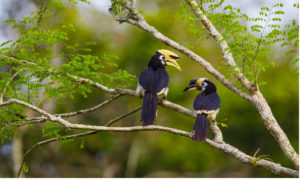 A pair of mating hornbills
A pair of mating hornbillsIt’s definitely worth dropping in to the visitor’s centre, which is 14 km from the main entrance. You can pick up a basic A4 map of the park here, detailing the major sights. There is also an exhibition, which includes a display of various stuffed animals and an informative video giving details on the park’s history and wildlife. The map also indicates the other main places of interest in the local vicinity i.e. several waterfalls and viewpoints, as well as a watchtower, along with six designated nature trails. Information about the trails are detailed on the back of the hand-out map, giving their length, the expected walking time and a brief description of the walk.
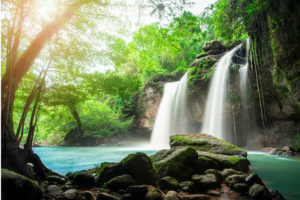
Typically, without any preplanning and little information, I attempted Trail 5, which was a designated 3 hour walk. The terrain was fairly challenging, and I didn’t appreciate a ‘trail’ would literally be a narrow jungle track. Visibility was limited to 4 or 5 metres and the only indication of being a ‘trail’ were the occasional red paint marks on trees. After about an hour or so walking I couldn’t progress any further because the ground conditions were just too boggy. Thus, if you’re visiting the park during the rainy season I would thoroughly recommend proper walking boots if you intend doing a bit of jungle trekking. Similarly, it would be a good idea take a pair of binoculars, especially if you intend to use the observation points. Incidentally, Nong Pak Chi watchtower is only a short trek from the visitor’s centre.
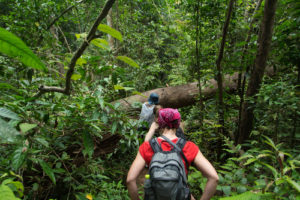
I must admit, the only animals I managed to see during my visit, were deer and macaques. Both roam freely even in open areas and are obviously used to human contact. I did also view numerous (unidentified) species of birds and a few very small snakes. And while, the distinctive call of the gibbon could be heard almost everywhere, they proved rather difficult to spot to an obviously untrained observer.
In hindsight, it would probably been better to have participated in guided tour. There are numerous local companies organising such excursions. Typical costs for a 1-day tour, range from 1,500 to 5,500 THB, depending on group size, which would include the 400 THB park entrance fee. Similarly, a four-day tour would cost somewhere in the region of 7,000 – 22,000 THB. For the latter, it should be possible to undertake a night safari, which increases the chances of encountering the park’s rarer animal species.
NB – Prices quoted as of September 2018 (when 32.3 THB = 1 USD)
